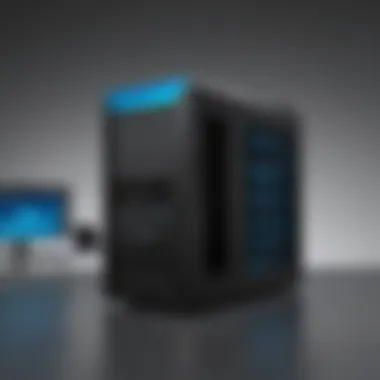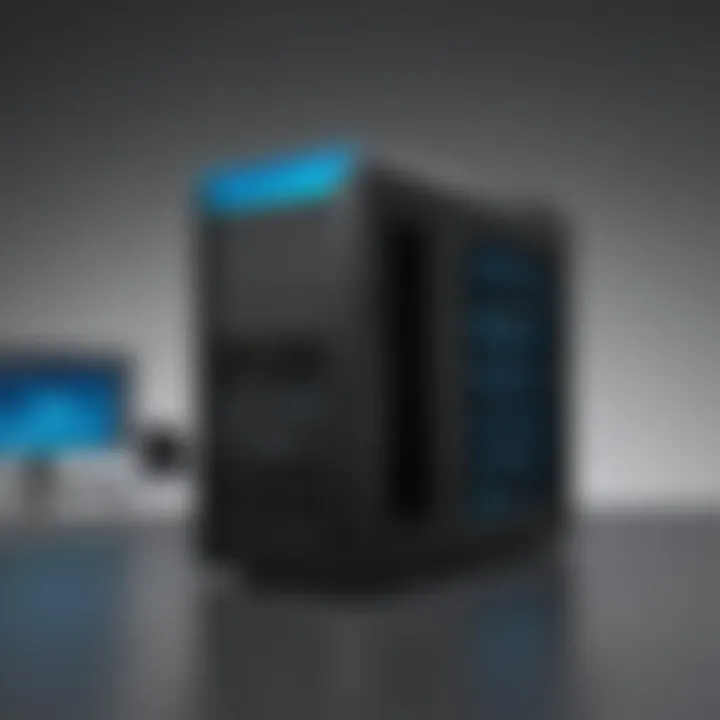Comparative Analysis of Azure Databricks and HDInsight


Intro
In today’s data-driven landscape, businesses rely heavily on cloud-based solutions to handle extensive data processing. With numerous platforms available, Azure Databricks and HDInsight stand out due to their unique capabilities. This article's aim is to unpack the functionalities, advantages, and limitations of these two platforms. Understanding their intricacies helps businesses navigate their selection process more effectively.
Azure Databricks is known for its integration with Apache Spark, allowing for rapid data analysis and machine learning capabilities. On the other hand, HDInsight offers a comprehensive suite for processing big data, supporting various open-source frameworks including Hadoop and Spark. As organizations expand their data needs, evaluating these platforms becomes crucial to ensure optimal performance.
The subsequent sections will delve deeper into the key features of both Azure Databricks and HDInsight, offering insights into their specific advantages and challenges, ultimately guiding users toward making informed decisions.
Intro to Azure Databricks and HDInsight
In the landscape of cloud-based data processing, Azure Databricks and HDInsight emerge as significant players. Understanding these platforms is vital for businesses seeking to optimize their data capabilities. This introduction will illuminate the essential characteristics and advantages of each while addressing considerations relevant to selecting between them.
Azure Databricks harnesses the scalability of Apache Spark with an integrated workspace designed for collaboration. This environment fosters enhanced productivity among data scientists and engineers. In contrast, HDInsight serves as a versatile cloud service that supports various open-source frameworks like Hadoop, Spark, and Kafka. The diversity it offers allows organizations to tailor their solutions according to specific data processing requirements.
The relevance of comparing these platforms lies in their unique offerings. Azure Databricks is often favored for its machine learning capabilities and seamless integration with Azure services. On the other hand, HDInsight is known for its broad compatibility with established big data frameworks, offering flexibility for different workloads.
By delving into these distinctions, businesses can gain clarity on which platform aligns better with their operational goals. The decision may hinge on factors such as existing infrastructure, team expertise, and specific project requirements. This comparative analysis aims to guide enterprises in making informed decisions by exploring the notable features and functions of both Azure Databricks and HDInsight.
Core Features Comparison
In evaluating Azure Databricks and HDInsight, a critical step is the core features comparison. This section will highlight the essential functionalities of both platforms. Understanding these features is important for businesses to determine which tool aligns better with their specific needs. Companies today demand efficient data processing, reliable machine learning capabilities, and flexible storage solutions. Thus, assessing these core aspects provides a foundation for more nuanced comparisons later on.
Data Processing Capabilities
Azure Databricks offers robust data processing capabilities. Built on Apache Spark, it allows for powerful distributed computing. Users can process large datasets efficiently. The integration of Spark SQL enhances performance for executing queries. Databricks also supports various programming languages such as Python, R, and Scala, giving data scientists multiple tools for analysis.
On the other hand, HDInsight embraces a more versatile approach. It integrates multiple frameworks, including Apache Hadoop, Spark, and Hive. This allows users to choose the best tool for their specific tasks. Furthermore, HDInsight offers seamless integration with Azure Blob Storage, making it easier to manage data. Both platforms are well-suited for processing vast amounts of data, but the choice largely depends on the specific requirements of the business.
Machine Learning Integration
When it comes to machine learning, Azure Databricks has a strong emphasis. It provides integrated workspaces for collaboration. Users can build, train, and deploy machine learning models easily. Tools like MLflow support experimentation and tracking, streamlining workflows. The Databricks Runtime simplifies the use of popular libraries like TensorFlow and Scikit-learn.
HDInsight, although not as specialized, does support machine learning. Its integration with Azure Machine Learning provides a traditional but effective approach. Users can still leverage its cloud services for predictive analytics. While the synergy is not as pronounced as in Databricks, HDInsight remains a functional option for various environments, including enterprises using different existing data architectures.
Data Storage Options
In terms of data storage, Azure Databricks provides users flexibility. It allows for connection to Azure Data Lake Storage and Azure Blob Storage. This connectivity benefits organizations that utilize other Azure services. They can seamlessly manage their data storage needs alongside data processing. In addition, Databricks offers Delta Lake, which enhances data reliability and performance.
HDInsight also connects well with various storage options. Its flexibility allows it to work with Azure Blob Storage and Data Lake Storage as well. Moreover, it can integrate with on-premises storage solutions. This aspect can be crucial for enterprises with hybrid models. The variety of storage configurations available makes HDInsight compelling for many organizations.
Real-time Processing
Real-time data processing is becoming increasingly essential for businesses aiming for immediacy in decision-making. Azure Databricks excels in this area. It supports structured streaming, enabling analytics on streaming data in real-time. Users can get insights almost instantaneously. This capability is particularly useful for applications requiring constant updates, such as fraud detection and online recommendations.
HDInsight also offers real-time processing abilities. While it supports real-time streaming through Apache Kafka and Spark Streaming, the implementation is less seamless compared to Azure Databricks. That said, organizations familiar with the broader Hadoop ecosystem may find HDInsight a comfortable environment for real-time workloads.
Choosing the right platform for data processing depends on specific needs, particularly regarding data processing, machine learning, and storage capabilities.
The variances in core features between these platforms underscore the necessity for a detailed examination aligned with organizational goals. Businesses must carefully weigh the strengths and limitations of each solution to make sound choices on their data strategy.
Performance Analysis
Performance Analysis is crucial when evaluating Azure Databricks versus HDInsight. This section focuses on key performance metrics that affect how these platforms handle data processing workloads. Speed and efficiency, along with resource management, are vital for small and medium-sized businesses aiming to optimize their data operations.
Speed and Efficiency
Speed in data processing can significantly affect business operations. Azure Databricks is built on Apache Spark, giving it an edge in handling large-scale data efficiently. It can perform in-memory processing, which is faster than traditional disk-based systems. Users can experience quicker data retrieval and more responsive analytics due to this architecture.
In contrast, HDInsight offers a choice between various processing engines, including Hadoop and Spark. This flexibility allows users to select the optimal engine for their specific data tasks. However, performance may vary based on engine choice and configuration. For example, when using MapReduce on HDInsight, users may encounter longer processing times compared with Databricks. Understanding the desired speed requirements is essential for leveraging either platform to its full potential.
A comparison of common tasks can illustrate differences in speed:


- Data loading: Databricks generally shows faster data ingestion from various sources.
- Query execution: The execution speed of complex queries often favors Databricks, especially when using caching.
Resource Management
Efficient resource management is required for maximizing performance in any cloud environment. Azure Databricks employs a dynamic scaling feature that automatically adjusts resource allocation based on workload demands. This elastic capability can help businesses save costs while ensuring performance meets the required standards.
Conversely, HDInsight offers a more manual approach to resource management. While it allows users to configure clusters for specific workloads, it may require more careful monitoring. Businesses may need to adjust resources manually to maintain performance, which can lead to opportunities for inefficiencies.
Both systems offer tools for monitoring resource usage, but Databricks often provides a more user-friendly interface for tracking performance metrics and managing cost efficiency. Businesses must weigh the need for automated scaling against more control for resource allocation when choosing between the two platforms.
"Choosing the right data processing platform based on performance needs can vastly improve operational efficiency and reduce costs."
In summary, performance analysis provides valuable insights into the capabilities of Azure Databricks and HDInsight. Speed and efficiency, alongside effective resource management, are fundamental in determining the suitable platform for diverse data processing needs.
Scalability and Flexibility
In the realm of cloud computing, scalability and flexibility are critical factors that determine the effectiveness of data processing solutions. For small to medium-sized businesses and IT professionals, adapting to changing data demands is crucial to maintaining operational efficiency. This section will evaluate how Azure Databricks and HDInsight approach these two aspects. Effective scalability allows organizations to increase or decrease resources according to their needs without hindrance, while flexibility ensures that platforms can integrate with a variety of tools and workflows.
Scaling Mechanisms in Databricks
Azure Databricks specializes in offering dynamic scaling mechanisms. It uses an auto-scaling feature that automatically adjusts the number of worker nodes based on workload demands. This benefit is especially useful during peak times, where user queries or jobs may spike. Users can configure minimum and maximum nodes, providing a balanced approach to resource consumption.
Furthermore, the Unity Catalog in Databricks enhances scalability by allowing for a unified governance model across all data assets. This approach reduces the time needed to search for and provision scalable resources. The platform's elasticity is beneficial for analytics, enabling teams to harness compute power as needed, avoiding overspending on unused resources.
Scaling Mechanisms in HDInsight
HDInsight offers a different perspective on scaling. It utilizes a more traditional scaling model involving manual scaling and cluster resizing. While it does have the option for auto-scaling, many users prefer the manual approach that allows them to set specific resource parameters. This does provide a good measure of control for IT professionals who wish to optimize their environment based on their unique workloads.
Moreover, HDInsight supports various cluster types, such as Apache Hadoop, Spark, and Storm, which means scaling can be done in a way that aligns with the specific technology stack of the organization. This flexibility allows businesses to manage different workloads effectively, albeit at the cost of increased complexity in managing the infrastructure. Users must actively monitor usage metrics to make informed decisions for scaling, which requires an investment of time and resources.
"The choice between auto-scaling in Databricks and manual scaling in HDInsight depends on the level of control you need over the computing resources."
Both platforms offer unique mechanisms for scaling, catering to different user preferences and needs. Databricks is often favored for its seamless and automatic approach, while HDInsight is suitable for those looking for granular control. Understanding these mechanisms allows businesses to harness the right platform according to their specific scalability and flexibility needs.
Ease of Use and User Experience
The significance of ease of use and user experience in cloud-based data processing solutions cannot be understated. In a landscape where data is the new oil, platforms like Azure Databricks and HDInsight offer powerful tools for data analysis and machine learning. However, if these tools are not intuitive or user-friendly, their potential can be wasted. Businesses need to consider how easily their teams can adapt to these platforms. This section will delve into the user interface and the learning curve involved in both solutions, providing clarity on how each solution caters to user experience.
User Interface Evaluation
An effective user interface is crucial in reducing the time needed to get accustomed to a new platform. Azure Databricks offers a relatively modern and patterned interface that promotes an organized workflow for data scientists and analysts. The navigation of its workspace is designed in a way that users can quickly find notebooks, jobs, and clusters, simplifying collaboration and project management. The relatively clean layout can make it easier for users to focus on data rather than navigating through complicated menus.
On the other hand, HDInsight presents a more traditional interface, which may not appeal to users who prefer a modern touch. Users might find it somewhat cluttered, as it often requires more steps to access certain features. However, its interface is still functional for those who are familiar with Microsoft’s ecosystem, creating a slight edge for existing Microsoft users.
"User interface can often make or break the experience when adopting new technology."
Learning Curve for Users
Learning curve assessment is essential when simplifying the onboarding process for new users. Both Azure Databricks and HDInsight have their set of challenges in this context.
For Azure Databricks, while the interface is more intuitive, the underlying complexities of Apache Spark can present a steep learning curve for newcomers. It requires users to familiarize themselves not only with the platform's layout but also with programming concepts and distributed computing. However, the availability of extensive documentation, tutorials, and community support can significantly ease this process.
HDInsight, in contrast, can initially appear more straightforward for users already accustomed to Microsoft services. Yet, the need for users to grasp the multitude of services it integrates with can lead to confusion for those new to this ecosystem. The broader range of tools available within HDInsight can be both a benefit and a drawback, as it can overwhelm inexperienced users.
This aspect highlights the need for organizations to account for their team’s proficiency and specific data processing demands in their decision-making process. Ensuring effective onboarding and ongoing support can mitigate the learning curve associated with either platform, ultimately influencing overall productivity.
Integration Capabilities
In the landscape of cloud-based data processing solutions, the integration capabilities of a platform determine its versatility and effectiveness. Both Azure Databricks and HDInsight offer distinct integration features that cater to different business requirements. Understanding these capabilities is crucial for organizations looking to leverage their existing tools and workflows. For a smooth operational flow, businesses need to prioritize how well their data processing solution can connect with other applications and services.
Third-party Tool Compatibility


Azure Databricks excels in its ability to integrate with various third-party tools. This is particularly significant for businesses that rely on specific applications for data analysis, visualization, or machine learning. Some notable third-party tools compatible with Databricks include Tableau, Power BI, and Apache Kafka. These integrations facilitate seamless data flow between systems, allowing users to harness the full potential of their data without requiring extensive reconfiguration.
Benefits of third-party tool compatibility in Databricks:
- Enhanced data visualization options through integration with tools like Tableau.
- Immediate access to real-time data streams due to compatibility with Apache Kafka.
- Flexibility to incorporate a wide range of machine learning frameworks.
On the other hand, HDInsight also provides solid support for third-party tools, though it may not offer as extensive a range of integrations as Databricks. HDInsight supports applications like Microsoft Power BI and Apache Kafka but may require more configuration for optimal effectiveness. This can pose challenges for businesses aiming for a quick deployment without delving into complex setups.
APIs and Development Tools
APIs play a vital role in the integration capabilities of both Azure Databricks and HDInsight. Databricks provides a comprehensive set of REST APIs, enabling developers to interact programmatically with their data environments. This openness allows for greater customization and development of workflows tailored to unique business needs. Databricks offers various SDKs that support multiple programming languages, making it easier for developers to create applications that integrate seamlessly.
In contrast, HDInsight also offers REST APIs, but its development tools may not be as robust or user-friendly as those of Databricks. Developers might experience a steeper learning curve when working with HDInsight's APIs. However, its integration with Microsoft development tools can streamline some production tasks.
In summary, organizations must assess their specific integration needs. While Azure Databricks shines in flexibility and user-friendly API access, HDInsight provides a solid option for businesses entrenched in the Microsoft ecosystem.
Security and Compliance
In today’s data-driven world, Security and Compliance have become essential topics for businesses adopting cloud-based solutions. Managing data securely is not just a regulatory requirement but also vital for maintaining trust with customers and partners. Both Azure Databricks and HDInsight offer robust security measures but vary in their approaches and features. This section outlines how each platform manages data security and compliance, emphasizing essential elements such as data encryption, access controls, and regulatory standards compliance. By understanding these aspects, organizations can make informed choices that align with their security needs and compliance mandates.
Data Security Features in Databricks
Azure Databricks incorporates several advanced security features designed to protect data integrity and ensure compliance with industry standards. Key data security functions include:
- Encryption: Databricks employs encryption for data at rest and in transit. Using Azure storage encryption ensures that customer data is safely stored, while TLS is used to secure data as it travels across networks.
- Role-Based Access Control (RBAC): This feature allows organizations to assign permissions based on user roles. By specifying who can access what, organizations can minimize the likelihood of unauthorized access.
- Audit Logs: Databricks provides detailed audit logging, helping organizations maintain oversight on user actions and dataset interactions. This is crucial for organizations needing to comply with regulatory requirements that demand accountability.
- Network Security: Azure Databricks supports virtual networks, allowing organizations to isolate resources securely. Such network segmentation strengthens security layers against potential threats.
These features make Azure Databricks a strong contender for businesses that prioritize data security and compliance.
Data Security Features in HDInsight
HDInsight offers a different set of security features tailored to its architecture and capabilities. It emphasizes both flexibility and compliance through various mechanisms. Important aspects include:
- Data Encryption: Similar to Databricks, HDInsight favors encryption at rest and in transit, ensuring data protection throughout its lifecycle. Additionally, integration with Azure Key Vault allows for secure key management, enhancing data safety.
- Identity and Access Management: HDInsight relies on Azure Active Directory for managing user access. This ensures that only authenticated users can interact with sensitive data, promoting a secure environment.
- Compliance Certifications: HDInsight maintains compliance with various standards such as HIPAA and GDPR, making it a suitable choice for organizations operating in regulated industries.
- Integrated Security Services: Services like Azure Security Center provide real-time security recommendations and alerts, adding an additional layer of security management.
Both platforms offer comprehensive security, but the right choice depends on individual organizational needs and regulatory landscapes. Understanding these differences can greatly aid in choosing the most suitable solution for your business needs.
Cost Considerations
Cost is a critical aspect when selecting a cloud-based data processing solution like Azure Databricks or HDInsight. Small to medium-sized businesses and entrepreneurs need to analyze total expenses to make informed decisions. These considerations go beyond mere pricing; they involve understanding value for money, potential ROI, and how costs align with specific business needs.
The pricing models of these two services vary significantly, and it is essential to evaluate them carefully.
Pricing Models of Azure Databricks
Azure Databricks employs a consumption-based pricing model, meaning costs fluctuate based on resource usage. This model provides flexibility, allowing businesses to pay only for what they utilize. The primary components of the pricing model include:
- Databricks Units (DBUs): This is a unit of processing capability per hour, which varies based on the type of workload.
- Compute resources: These are charged according to the type and number of virtual machines used.
- Storage costs: Data stored in Azure Blob Storage incurs additional charges.
Such a model can be appealing to businesses that experience variable workloads or prefer to scale their resources as needed.
Additional Benefits
- No upfront costs: Organizations can adapt to changing data demands without heavy initial investments.
- Optimized resource allocation: Businesses can manage expenses effectively by aligning spending with usage patterns.
Pricing Models of HDInsight
HDInsight, on the other hand, operates on a pay-as-you-go model as well, but with a different focus. While it offers flexibility, there are specific elements to watch:
- Cluster pricing: Organizations are charged for the virtual machines and storage resources allocated to their clusters. The kind of cluster (e.g., Hadoop or Spark) also influences costs.
- Duration of usage: Companies pay for the duration their cluster remains operational, increasing costs if not managed properly.
- Additional services: Features like Azure support and advanced networking options may incur extra fees.
Important Notes


- Predictable budgeting: Some businesses may find it easier to estimate costs over a longer term due to cluster management.
- Possible inefficiencies: If clusters are not optimized or monitored, costs could escalate.
"Selecting the right pricing model depends on usage patterns and specific business needs. Always consider scalability and flexibility."
Use Cases and Applications
Understanding the Use Cases and Applications of Azure Databricks and HDInsight is crucial for businesses aiming to optimize their data processing needs. The specific implementations of each platform play a significant role in determining their respective strengths and weaknesses.
Evaluating these use cases helps organizations identify the right tool based on their operational requirements and industry context. By aligning data strategies with the right platform, businesses not only enhance efficiency but also maximize resource utilization.
Industries Favoring Databricks
Azure Databricks attracts organizations primarily in the sectors of finance, e-commerce, and technology.
- Finance: The financial industry leverages Azure Databricks for real-time analytics and risk management. Financial institutions analyze streaming data quickly, allowing them to make informed decisions and meet regulatory compliance.
- E-commerce: E-commerce companies use Azure Databricks to optimize customer experiences through personalized recommendations. By processing large volumes of transaction data, they develop insights into customer behavior and purchasing patterns.
- Technology: Many tech firms utilize Databricks for machine learning applications. Its integrated capabilities allow them to build and deploy models rapidly, thereby facilitating innovation in products and services.
Industries Favoring HDInsight
In contrast, HDInsight finds favor in sectors such as healthcare, retail, and telecommunications.
- Healthcare: HDInsight helps the healthcare sector manage vast data sets from patient records, medical imaging, and research. The platform provides the tools to conduct large-scale analytics while ensuring compliance with privacy regulations.
- Retail: Retail businesses utilize HDInsight for inventory management and supply chain analytics. By analyzing data from multiple sources, they improve operational efficiency and customer satisfaction.
- Telecommunications: The telecom industry benefits from HDInsight by analyzing call detail records and network performance metrics. This helps companies enhance service quality and manage infrastructure effectively.
“Choosing a platform like Azure Databricks or HDInsight should align with the specific operational and industry requirements rather than general trends.”
In summary, the choice of platform is influenced by the industry in which a business operates. Each platform excels in different areas, making it vital for businesses to assess their unique needs before decision-making. The right choice can significantly impact data management and analytical capabilities.
Customer Support and Resources
Customer support and resources are essential considerations when evaluating cloud-based platforms like Azure Databricks and HDInsight. Effective support systems enhance user experience, provide necessary guidance during critical operations, and ultimately contribute to better decision-making for businesses. In a rapidly changing technology landscape, having reliable support can help companies to address challenges efficiently, mitigate risks, and leverage full capabilities of the chosen platform. This section will outline the support options available for both Azure Databricks and HDInsight, emphasizing the strengths and potential limitations of each.
Support Options for Databricks
Azure Databricks offers several support options for its users. One key feature is the Azure Support Plans, which provide varying levels of assistance based on subscribers' needs. The plans range from basic support, ideal for non-production environments, to more comprehensive options that include 24/7 technical support and quicker response times. Each plan caters to different business requirements, enabling organizations to choose the support that aligns with their operational needs.
Additionally, Azure Databricks has extensive documentation available online. This documentation covers topics from basic setup to more advanced functionalities. Users can find tutorials, troubleshooting steps, and best practices that can help them maximize the value of the platform. The support team is accessible through the Azure portal, allowing direct communication and swift issue resolution.
Another resource offered is the community forums, where users can engage with peers and share experiences. This feature fosters a collaborative environment, enabling individuals to learn from others' challenges and solutions.
Support Options for HDInsight
Microsoft HDInsight also provides a range of support options to its users. Similar to Azure Databricks, HDInsight users can select from various Azure Support Plans tailored to their specific needs. Each plan includes a combination of technical support, including workload optimization and performance tuning recommendations.
HDInsight's documentation focuses on guiding users through complex setup processes and maintaining clusters. It includes how-to articles, operational guidelines, and troubleshooting tips aimed at both new and experienced users. This level of detailed guidance helps users navigate common complexities faced in the cloud environment.
Moreover, HDInsight users can benefit from Microsoft Learn, an online platform that offers a variety of learning materials, including video tutorials and hands-on labs. This platform encourages continuous learning, which is vital in keeping up-to-date with new features and capabilities.
A significant aspect of HDInsight’s support ecosystem is its dedicated community contributions. The users have access to discussion boards and forums where they can ask questions and share knowledge. With such support systems in place, organizations using HDInsight can feel more confident in their ability to effectively utilize the platform.
The End and Recommendations
The comparison between Azure Databricks and HDInsight serves to illuminate critical aspects of data processing platforms in the cloud. Each tool has distinct features that cater to varying business requirements. Understanding these differences is fundamental for stakeholders. The success of data strategies lies in selecting the solution that aligns with company goals and operating environments.
Addressing final thoughts on both platforms, several factors emerge as paramount in making a decision. Azure Databricks excels in its seamless integration with Apache Spark and its dynamic collaborative environment. This makes it attractive for organizations focused on data science and machine learning. On the other hand, HDInsight's strength lies in its ability to process large datasets and support multiple frameworks, which might appeal more to traditional data engineering teams wary of frequent changes.
Final Thoughts on Both Platforms
In summarizing the strengths of Azure Databricks, it is important to acknowledge its advanced machine learning capabilities and enhanced collaboration tools. The environment encourages experimentation and faster model development, which is crucial for businesses that prioritize speed in innovation.
Conversely, HDInsight is a robust, enterprise-grade solution that offers consistency and reliability for extensive batch processing. Its ability to manage varied data types within a single framework can be a genuine asset.
"Choosing between Azure Databricks and HDInsight ultimately comes down to the specific needs of the business, including technical infrastructure and team expertise."
Choosing the Right Solution for Your Business
When considering the appropriate platform, small to medium-sized businesses should conduct a thorough assessment of their unique requirements. Key considerations might include:
- Existing Skill Sets: Determine the familiarity of your team with data processing technologies. Azure Databricks may favor users experienced with Spark, while HDInsight may work better for teams familiar with Azure services.
- Scalability Needs: Identify how well each platform can handle growth in data and user demand. Azure Databricks' auto-scaling features may help manage sudden workloads effectively.
- Budget Constraints: How accessible are the pricing models of each platform? Compute and storage pricing can vary widely.
Ultimately, the decision-making process should leverage feedback from various stakeholders, including IT professionals, data scientists, and financial decision-makers. This collaborative approach ensures that selected solutions cater to immediate needs while being adaptable to future changes.















